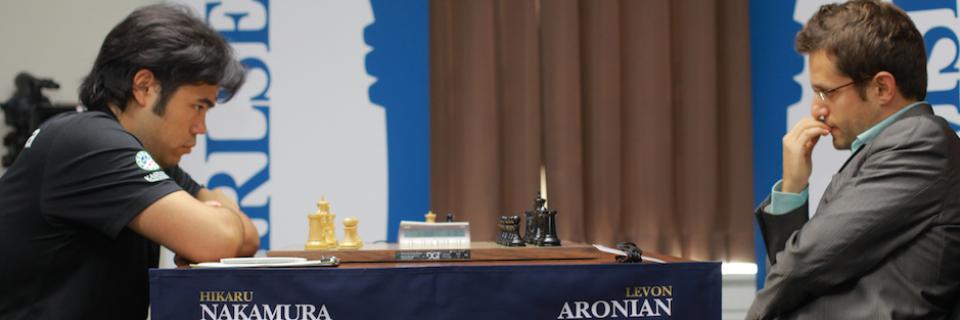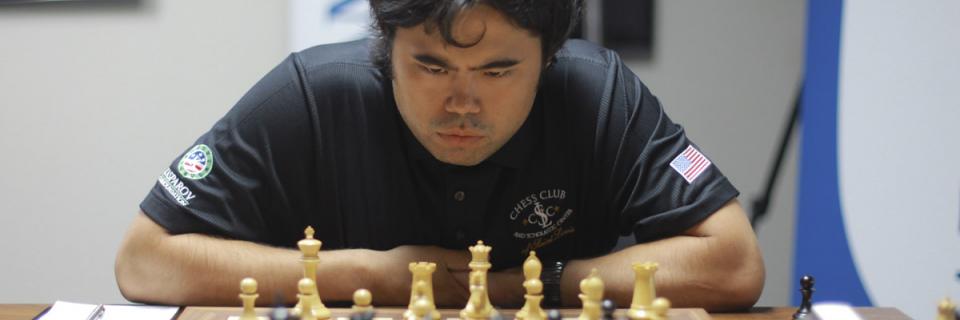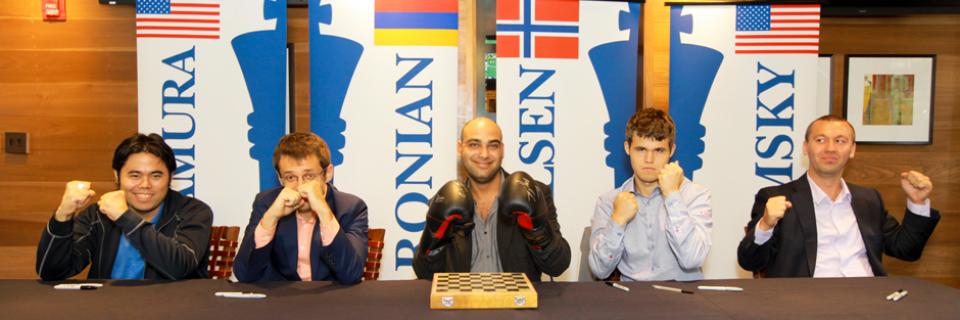2012 U.S. Championships News
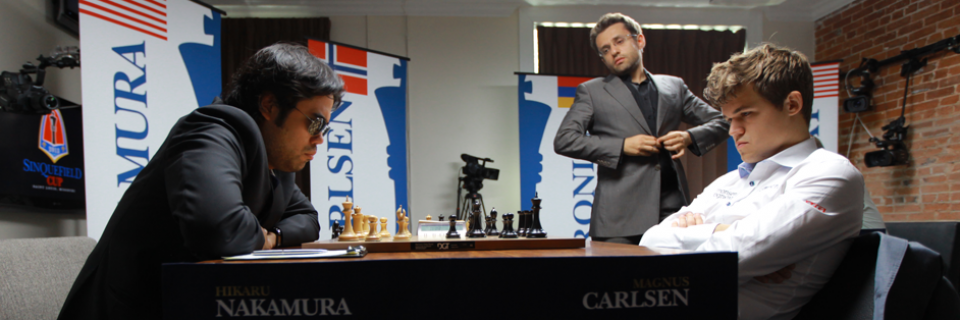
GM Hikaru Nakamura, GM Levon Aronian and GM Magnus Carlsen all have chances at winning the inaugural Sinquefield Cup.
By Brian Jerauld
Game annotations by GM Ben Finegold and GM Ian Rogers
SAINT LOUIS (September 14, 2013) -- There’s just one round left in the strongest tournament ever held on American soil—one game to play for the Sinquefield Cup.
After draws on both boards on Saturday, including a pivotal match between frontrunner Magnus Carlsen (3.5/5) and Hikaru Nakamura (3.0/5), the tournament standings remain the same. Levon Aronian (2.5/5) stays within striking distance of both leaders, and the result of his impending Sunday morning duel with Carlsen could play out to several storylines.
The two played to a draw in their first meeting on Tuesday. Nakamura seeks his second win against Gata Kamsky (1.0/5), who looks to play spoiler with the white pieces.
It is no secret that Kamsky is having a rough stay in Saint Louis. So if you can’t beat ‘em, join ‘em.
The reigning U.S. champ united with the newly popular theory that Aronian’s 1.d4 needed some work against the Dutch defense, a secret that Carlsen had revealed with great effect in round 2. Last Tuesday, Aronian had quickly lost white’s edge against Carlsen’s Dutch, falling into a middlegame that offered him no initiative and a grueling path to a draw.
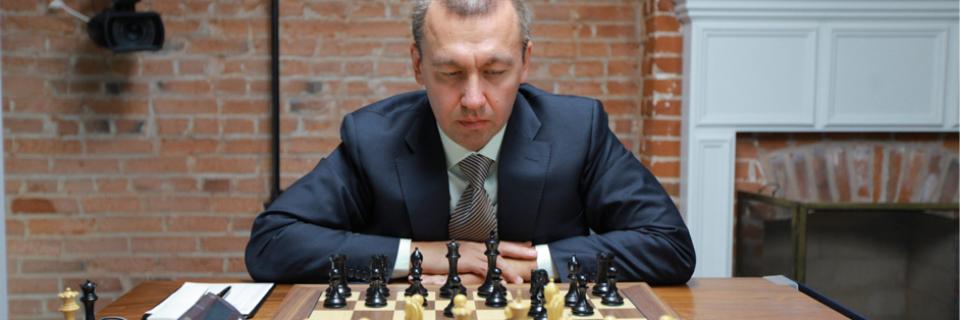
GM Gata Kamsky jumped on the bandwagon, employing the Dutch against GM Levon Aronian in round 5.
It was a decent enough idea for Kamsky, who is seasoned in the Dutch and was yearning for a balanced game of chess in the Sinquefield Cup. He looked to lean on an advantage where Carlsen could not.
“I’ve played the Dutch for a number of years now; it’s an interesting opening. If white screws up, he can possibly get in a worse position,” Kamsky said. “I’m curious why [Aronian] defensed this Bf4 set up. After the game, of course, it was justified, but I don’t think white has such a serious advantage by playing this line.”
Indeed, 5. Bf4 was a questionable move against Kamsky, just as it had been against Carlsen. The improvement on Saturday afternoon, however, came at 8.Bg3, a move that did avoid the tactical mess that Carlsen had introduced, but still did little to prevent black equality. Kamsky earned himself the bishop pair with 10…Nxg3.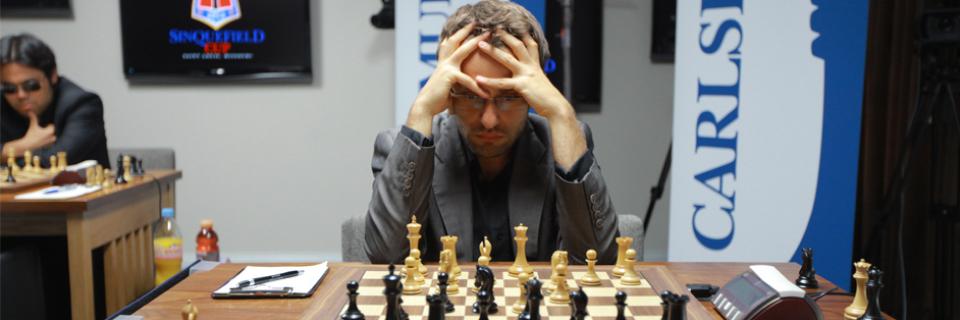
GM Levon Aronian controls his own fate as he squares off against GM Magnus Carlsen, the tourney leader, in the final round.
By the middlegame, the American was pushing with initiative, ultimately introducing the clever 27…Qf6. The interesting double attack threatened Aronian both in material, via a queen-rook skewer, as well as position, setting up for the h4 break. It baffled Aronian, who went into a deep think on his response, at a time when his clock wasn’t forgiving. It fell below ten minutes before he decided on 28. Nxh5.
“I couldn’t really see a good way for me to play,” Aronian said. “I’m not sure [28. Nxh5] was the best move, but I felt that at least there is some simplification, and I thought, ‘I’m not getting ‘mated, so I shall play that one.’”
It worked, though not without drama. The pawn grab did little more than open up the h-file and a direct lane to the white monarch, an exploit that Kamsky pressed immediately. A rook-and-queen battery briefly brought the leading lady too close for comfort, though ultimately into a futile position. The queens and eventually rooks were traded, leaving the curse of the opposite-colored bishops. The game drew on the 44th move.
Aronian - Kamsky annotated by GM Ian Rogers
Though the Sinquefield Cup has already featured five wins through ten games, Saturday’s Nakamura-Carlsen tilt was what most might expect from a super tournament: Two of the world’s elite, refusing to give an inch. The draw-by-repetition served as the quickest match of the tournament, only 32 moves, and featured a delicate balance of the smallest advantages.
Perhaps the only prize Nakamura could grab from Carlsen’s Berlin defense was the bishop pair, moving his queen’s knight six times to achieve 15. Nxc8. Nakamura brought the game into new territory with 16. g3, though it was Carlsen who pressed the issue with 22…f4.
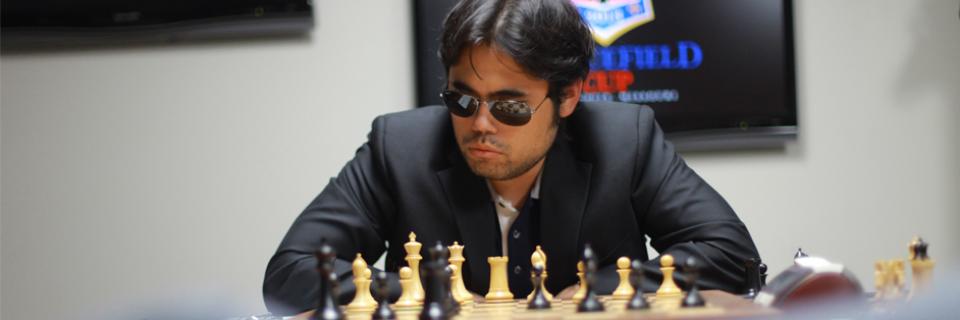
GM Hikaru Nakamura donned shades once more in his tilt against GM Magnus Carlsen, but his first victory against the World No. 1 remained elusive.
“I thought that I might be a little bit better, but I think it’s a question of whether this whole idea of f4 works or doesn’t,” Nakamura said. “Unfortunately, at the end, he was able to bail out.”
Clearly, f4 did not work to anyone's favor. Though it looked precarious, the attack found no future, and Nakamura simply chased Carlsen’s queen into repetition.
“I’m usually not too unhappy with a draw with black against such strong players,” Carlsen said. “I was kind of hoping he would over-press, and at the end I decided not to play out of a draw ... because I was hoping he would play on and play for a loss. But obviously he’s much too good of a player to screw it up.”
Nakamura - Carlsen annotated by GM Ben Finegold
Standings After Round 5
| No. | Name | Rating | Total |
|---|---|---|---|
| 1 | Magnus Carlsen |
2862 |
3.5 |
| 2 | Hikaru Nakamura |
2772 |
3 |
| 3 | Levon Aronian | 2813 | 2.5 |
| 4 | Gata Kamsky | 2741 | 1 |
Pairings for Round 6 - 09/15/2013
| No. | White | Rating | Result | Black | Rating |
|---|---|---|---|---|---|
| 1 | Carlsen, Magnus |
2862 |
- | Aronian, Levon |
2813 |
| 2 | Kamsky, Gata | 2741 | - | Nakamura, Hikaru |
2772 |

World No. 1 Magnus Carlsen took over sole posession of first place by besting the reigning U.S. Champ Gata Kamsky in round 4. Carlsen was exhausted after the game.
By Brian Jerauld
Games Annotated by GM Varuzhan Akobian and GM Ronen Har-Zvi
SAINT LOUIS (September 14, 2013) -- It was another round of fighting chess and another day of decisive results at the inaugural Sinquefield Cup. The event, held at the Chess Club and Scholastic Center of Saint Louis, now features five wins through eight games.
Friday’s fourth-round victories were good enough to rattle the overall standings: World No. 1 Magnus Carlsen toppled an uninspired Gata Kamsky to move into clear first with 3/4, as Hikaru Nakamura lost his leader-status after stumbling out of the gate against Levon Aronian. The loss brings Nakamura into second place with 2.5/4, while Aronian has climbed back into the tournament with 2/4. Kamsky has a half-point through four rounds.
After his game, Nakamura expressed clear displeasure with his opening choices, highlighting 7. … a6 and 8. … b5 in his King’s Indian Defense as poor decisions. A questionable 10. … h6 also proved to be a dog that would bite him later in the game.
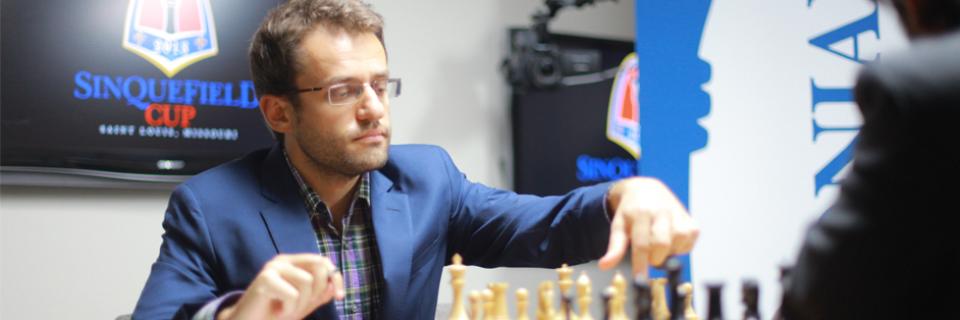
GM Levon Aronian crept back into contention with a victory tourney leader GM Hikaru Nakamura.
After Nakamura took his king’s knight on a queenside run from f6-e8-c7-a6, ultimately finding a cozy outpost with 17. … Nb4, Aronian offered an interesting relocation of his own cavalry with 19. Ne2. He followed with 20. h4, the first charge toward the black monarch.
He was not met with adequate resistance. Nakamura answered with 20. … c4, which opened the fight on the queenside but allowed Aronian to push a pawn to the pivotal h5 square. White instantly took the advantage, ushering a desperation sacrifice from Nakamura with 23. … N6xd5, trading his minor piece for both of white’s center pawns with the hope for some counterplay.
“[Nakamura] had to do it,” Aronian said of the sacrifice. “It was hopeless for black, but any way was hopeless ... of course, I should have played Qd1 after Bd5, and then just win by attacking his king – an extra piece helps, normally.”

GM Levon Aronian's defeat of GM Hikaru Nakamura helped allowed GM Magnus Carlsen to grab hold of clear first after four rounds.
Indeed, Aronian’s selection of 25. Rxc8, instead of dropping his queen to safety, left some light in Nakamura’s tunnel. The American quickly traded queens off the board.
“Levon tends to do this quite often,” Nakamura said of the queen trade. “He gets in these winning positions and doesn’t convert them in time or makes them very difficult. … It’s not the first time. It gave me some practical chances, but it’s not like I was playing a weak player.”
Aronian converted his winning position just fine. After picking up an extra pawn with 37. Nxe5, the minor piece endgame served as a masterful display of technique for the World No. 2, who executed down the stretch of the longest game of the Sinquefield Cup thus far. The American conceded on the 61st move.
“Overall, just a bad decision in the opening to try and play this a6-b5 gambit,” Nakamura said. “All credit to Levon for playing well. I should have made better decisions in the opening and made them out to work, at least, instead of just giving him a free point.”
Aronian-Nakamura annotations by GM Varuzhan Akobian
Kamsky had found his way into several decent positions through the first cycle of the tournament, perhaps only imploding after some admitted over-aggression, but on Friday he never found comfort.
He attacked Carlsen with the exchange Ruy Lopez and took the game down an uninspiring line, which was quite unlike the aggressive Kamsky from the start of the tournament. Not waiting around, Carlsen’s 14. … Ng4 gave the game the flair it needed as he eyed the h2 pawn.
Kamsky lost more than a tempo with a questionable 17. Nd2 and, by 18. … Bg3, Carlsen’s army was dangerously active on the open board while white sat uncomfortably undeveloped. Desperate to activate, Kamsky pushed 22. c3?, essentially sacrificing the pawn with nothing to show.

GM Magnus Carlsen squandered an early advantage with inaccurate play, but ultimately converted the win against GM Gata Kamsky.
For a while, however, it appeared Kamsky, who had fought valiantly down the stretch in his first-round tilt with Carlsen, might hold the draw. The Norwegian did not display his standard razor sharpness, choosing an uncertain path through the middle game that allowed white to hunker down.
Carlsen’s 45. … Rxd2+, which appeared to push toward a bishop endgame with no clear lines to victory, looked like the antidote Kamsky needed – but 50. Bc3?? was a clunker. Carlsen was quick to march his b-pawn with tempo, eventually creating passers on both wings and then challenging the remaining bishop for the important a1-h8 diagonal.
“At some point I lost control, but fortunately it was enough,” Carlsen said. “Today, in the fourth hour of play, I was playing so badly. The same against Levon the other day: hesitating and burning huge amounts of time.”
Kamsky-Carlsen annotations by GM Ronen Har-Zvi

GM Hikaru Nakamura played World No. 1 GM Magnus Carlsen to an exciting draw in round 3 of the inaugural Sinquefield Cup.
By Brian Jerauld
Games annotated by GM Ian Rogers and GM Ben Finegold
SAINT LOUIS (September 12, 2013) -- At the 1959 Candidates Tournament, Hungarian GM Pal Benko, desperate to refute the “hypnotic stare” of the legendary Mikhail Tal, pulled from his pocket a defense never tried before: Reflective sunglasses. Tal had decisively won every match of their career to that point.
In the third round of the Sinquefield Cup, GM Hikaru Nakamura decided to try out Benko’s variation.
The eccentric American No. 1 strolled into the Chess Club and Scholastic Center of Saint Louis on Wednesday, donning a pair of shades for his game against Norway’s Magnus Carlsen. Carlsen, perhaps through hypnotism, decisively held the lifetime series between the two at 7-0 with 13 draws.
“For the first time in his life, Carlsen has to look at his opponent and see himself," quipped GM Ian Rogers, who was offering live commentary to a crowd at Lester's restaurant nearby the Chess Club. "That will be scary.”
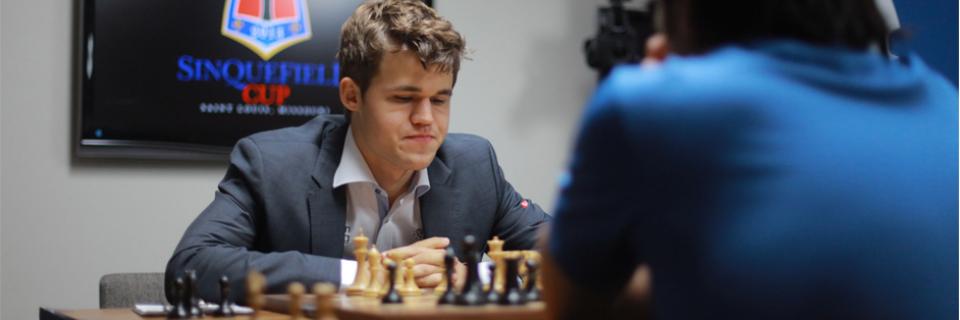
GM Magnus Carlsen seemed uncomfortable at times but maintained his composure to secure the draw against tourney leader GM Hikaru Nakamura.
The plan didn’t work out so well for Benko, who was wiped off the board in 20 moves. Tal eventually threw him a bone by allowing perpetual check saying: “When I want to win against Benko, I win; when I want to draw, I draw.”
Nakamura’s version of the defense was good enough for a legitimate draw against Carlsen, maintaining the standings at the tournament’s halfway point.
Heading into the rest day, Nakamura stands as the front-runner with 2.5/3 points, while Carlsen trails just a half-point behind in second place. Armenia’s Levon Aronian sits in third with 1/3 after battling to a draw with reigning U.S. Champion Gata Kamsky, who earned his first half-point of the tournament.
“I just felt like doing something different,” Nakamura said with a smile. “Why not? Life is short, might as well have some fun every once in a while, considering how overly serious chess seems to be at times.”
It was Nakamura's first time commanding the black pieces this week, and he responded with the King’s Indian Defense after Carlsen’s 1. d4, which had produced positive results against the American in the past. But Carlsen’s 10. b3 brought the game into fresh territory, and Nakamura’s response of 10. … g5 gave the battle a sharp edge.
Though both players each had an hour on their clock by the 16th move, the board had ventured into a position that Nakamura normally enjoys – a unique pawn structure and heavy tactical lines with plenty of potential pitfalls. Eventually, the Norwegian’s clock became a factor.
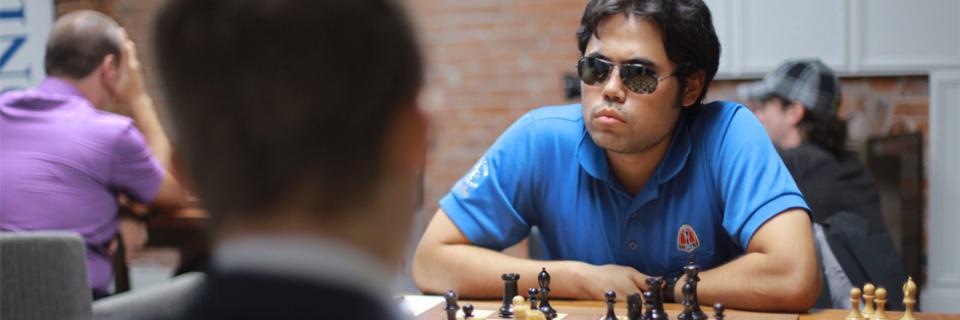
GM Hikaru Nakamura was unable to secure his first-ever win against GM Magnus Carlsen in classical play. The draw brings his lifetime record against Carlsen to 0 wins, 7 losses and 14 draws.
“It was a complicated game so, to some extent, I needed to use time,” said Carlsen, whose clock fell under a minute while he thought on his 31st move, still nine moves away from time control. “But often when you think for a long time, you don’t come up with the best moves.”
To the contrary, the play of both grandmasters down the stretch was incredibly accurate, setting off fireworks when Carlsen recaptured with 21. Rxc3, allowing 21. … Bf5, winning the exchange. 34. … Rxb7 was dangerously interesting and Nakamura’s only choice to push forward, despite bringing a white pawn to the seventh rank. This became a liability that ultimately locked all the remaining major pieces to their current squares. Nakamura offered a handshake after 42. … h5.
Carlsen-Nakamura annotated by GM Ian Rogers
Kamsky had been aggressive coming into the Sinquefield Cup. “This is an event where you can just play chess and there are not consequences,” he said after a first-round loss to Carlsen. Yet heading into round 3 he had nothing to show for it and appeared to change his strategy for his matchup against Aronian.

World No. 2 GM Levon Aronian split the point with U.S. No. 2 GM Gata Kamsky in round 3.
Kamsky seemed less interested in finding an advantage in the opening, allowing early equalization but simultaneously working his army into a rock-solid position by move 13. From there, the U.S. No. 2 leaned on his position to slowly increase white’s advantage – but something fizzled along the way.
“I just didn’t want to lose today,” Kamsky said. “I had a really nice edge, and then there was an opportunity to increase the edge. At the moment, that was my original intention, but then somehow I got sidetracked and actually got into a worse position, which I was actually really lucky to save.”
Kamsky blamed his 22. Rac1 for leading him astray, not executing on his plan to push e5 and getting his knight to e4. A temporary lack of solid ideas for white ushered in opportunities for Aronian’s black army, equalizing with 25. … Qe7 and going on the attack by 32. … f5. Momentarily, the advantage seemed greater for Aronian, who opted out of a draw by repetition with 37. … Bd5. Regardless, it allowed Kamsky to trade the queens off the board and go on to defuse the situation. The players agreed to a draw six moves later.
Kamsky-Aronian annotated by GM Ben Finegold
Standings After Round 3
| No. | Name | Rating | Total |
|---|---|---|---|
| 1 | Hikaru Nakamura | 2772 | 2.5 |
| 2 | Magnus Carlsen | 2862 | 2 |
| 3 | Levon Aronian | 2813 | 1 |
| 4 | Gata Kamsky | 2741 | 0.5 |
Pairings for Round 4 - 09/13/2013
| No. | White | Rating | Result | Black | Rating |
|---|---|---|---|---|---|
| 1 | Kamsky, Gata |
2741 |
- | Carlsen, Magnus | 2862 |
| 2 | Aronian, Levon |
2813 |
- | Nakamura, Hikaru |
2772 |
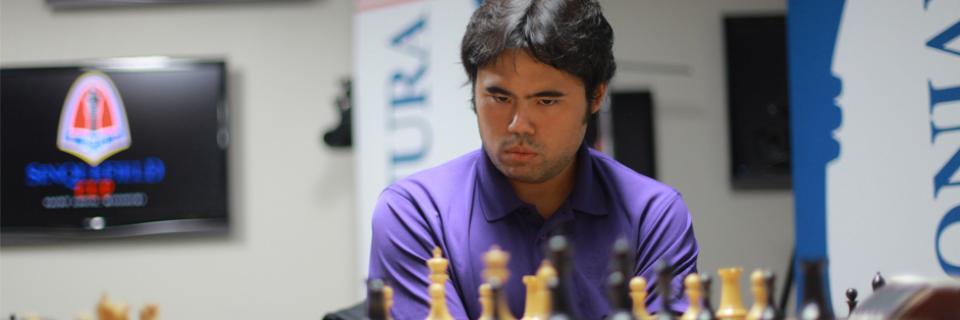
With his victory today, GM Hikaru Nakamura moved up to No. 5 in the world on the live rating list and is less than a point away from overtaking GM Alexander Grischuk for the No. 4 spot.
By Brian Jerauld
SAINT LOUIS (September 10, 2013) -- Hikaru Nakamura is done with the side dishes. Now bring on the main course.
Through the first two rounds of the inaugural Sinquefield Cup, the American No. 1 has already gotten fat from both number-twos in the quartet, first gobbling up a blunder by World No. 2 Levon Aronian on Monday, and then chewing through U.S. No. 2 Gata Kamsky on Tuesday to remain perfect through the tournament. Nakamura’s two points hold him in clear first in the six-game, double round-robin Sinquefield Cup, after World No. 1 Magnus Carlsen equalized early and convincingly in his 36th classical game against Aronian – but could not find a way to topple the Armenian king. The draw gave Aronian his first half point of the tournament and pulled Carlsen into second with 1.5/2. Kamsky still seeks his first tally.
Both number-ones – America’s Nakamura and the World’s Carlsen – will meet on Wednesday for the last game of the first cycle. Kamsky will command white for the first time in the tournament, against Aronian.

GM Gata Kamsky was out maneuvered in a tactical melee as he neared time control in round 2 against GM Hikaru Nakamura.
It would seem the United States’ top two players would have more of a history with each other, especially considering the world travelers have traded the title of U.S. Champion for the past five years, but much of 25-year-old Nakamura’s uprising came during 39-year-old Kamsky’s eight-year hiatus from the game. The two had met just eight times before the Sinquefield Cup, with six draws and a victory each; Tuesday proved to be a tiebreaker.
Despite his usual selections of 1. d4 or 1. Nf3 against Kamsky, Nakamura opened with 1. e4 for the second day in a row, to which Kamsky – on the attack after Monday’s loss to Carlsen – answered with the Kan variation of the Sicilian. Though both players would be nearly playing the increment by the 40th move time control, the game’s opening sped off at a furious pace for the first dozen moves, with early action.
Nakamura’s 9. Re1 looked innocuous, but his intentions became clear when Kamsky chased the white knight on c3, ushering 11. Nd5 – a square that black attacked twice, but with dangerous consequences upon capture. And still on his fast opening attack, Nakamura dropped 12. Qh5 with authority, immediately getting up from the board to let Kamsky think about the already dangerous position. But it was Nakamura who would give the game its first deep think, dropping nearly 30 minutes from his clock after Kamsky’s novelty response of 12. … Ne7.
Early signs of trouble turned into the real deal by 20. Qxf6, leaving Kamsky with a permanently weak king, a disharmonious army and a mounting white attack on the doorstep. The silver lining to his dreadful position, however, was Nakamura’s clock, which was 30 minutes lighter than Kamsky’s by the 22nd move.
Nakamura converted the first material advantage with 24. Bxh7, though it seemed to stifle his railroad momentum. At the cost of several tempi to pull his bishop back to safety, Kamsky found counterplay and eventually equalization with 28. … Qd6. Nakamura was under five minutes after 29. Rf1.
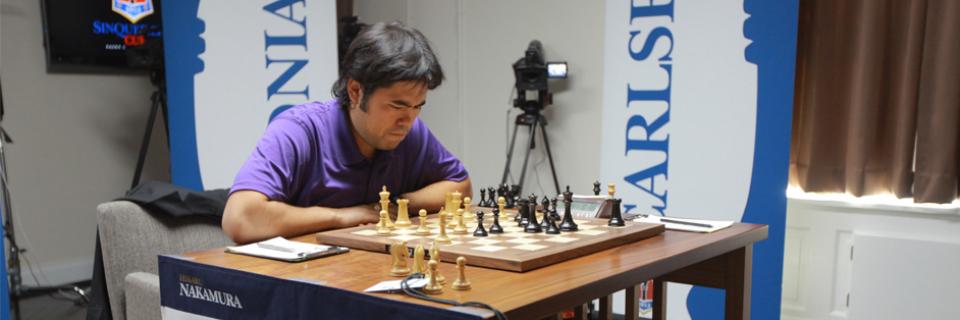
GM Hikaru Nakamura now stands alone atop the leaderboard with a perfect 2/2 score.
But 32. … Kb7 was a question mark for Kamsky, and Nakamura – a blitz world champion – was up to the task of keeping this new advantage. 35. Qc5 brought the white queen thrashing into the black camp, easily cracking open the position despite the threatening clock. The game was all-but over by time control.
“Probably around move 28-29, I was much more concerned about the time pressure mainly because there were many moves to consider, plans to consider for both sides; you can’t just make moves instantly,” Nakamura said. “When you’re playing at this level, any mistake is one too many. It’s quite nerve-racking, but I feel like I defended it quite well.”
Nakamura-Kamsky Annotations by GM Ben Finegold
Looking ahead to their Tuesday matchup after Aronian’s devastating blunder-loss on Monday, Carlsen proclaimed that he would “try to kick him while he’s down.” But nobody expected Carlsen to wear steel-toed boots.
The World’s best stomped all over the opening of the world’s next-best, first shocking Aronian’s 1. d4 with a Dutch defense that had spent nearly a decade on the Norwegian’s shelf, and then finding early equalization by move 11. … Ng5.
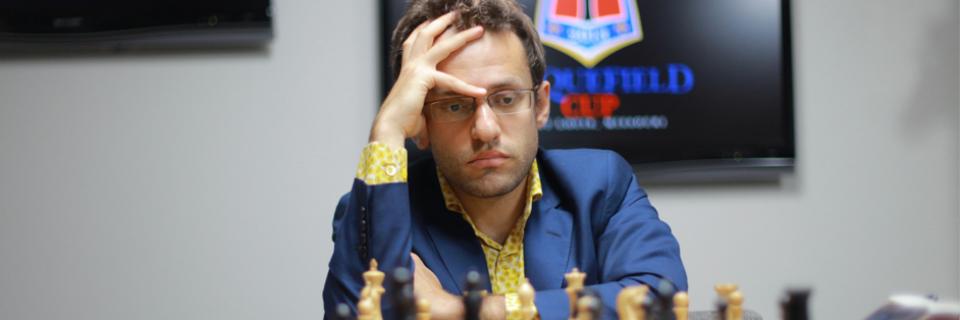
GM Levon Aronian fought an uphill battle all day and was fortunate to notch his first half point of the tourney against the World No. 1 Magnus Carlsen.
“I thought Aronian’s game against the Dutch hadn’t been particularly impressive,” Carlsen said. “I thought ‘Why not give it a try?’ especially as I was in a very good mood after my win yesterday. I got an excellent position, nothing to complain about there.”
Indeed, after an ugly looking 13. f4 was needed to chase the black queen, Aronian shifted fully into defensive mode after 15. … c5 locked Carlsen’s knight onto a brutal d4 outpost. Picking his poison, Aronian pushed 20. a4 to stop the b5 break, though it exposed weak squares on the white queenside. Smelling blood in the water, Carlsen was quick to redeploy his queen, stringing Qd8-Qa5-Qb4 and pushing his position to a near full-point advantage – seemingly with material on the way.
But Carlsen could not find a way to break the back of Aronian, who weathered the storm and slowly traded pieces to drown black’s attack. Despite spending most of the game in time trouble and without initiative, Aronian had all major pieces traded off the board by 37. Kxe1 and needed no use of the 40-move time bonus. Carlsen accepted his handshake before the 41st move.
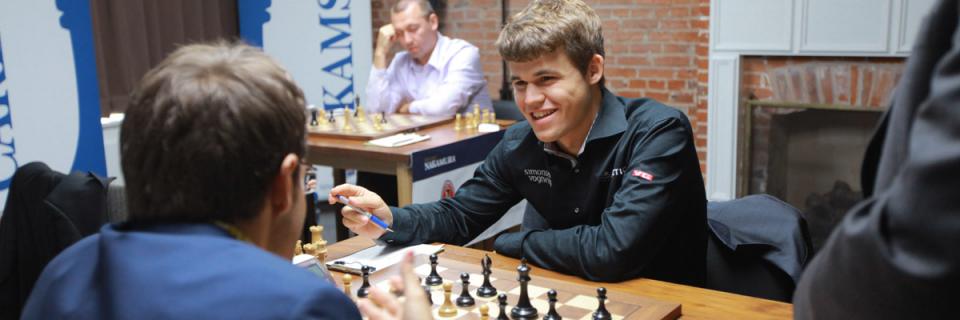
GM Magnus Carlsen will have the white pieces agaisnt tournament leader GM Hikaru Nakamura tomorrow.
“I was a bit too indecisive,” Carlsen said. “There were a lot of attractive options, and I didn’t choose the right one, evidently. For instance, I could have sacrificed my rook for a bishop at some point and gotten a fat pawn and some very active pieces. But I didn’t see anything really clear in that line, so I decided to postpone the critical moment a bit - and then it all just fizzled out. It was disappointing, but (Aronian) also deserves credit for defending such a grim position.
Aronian-Carlsen Annotations by GM Ian Rogers
Standings After Round 1
| No. | Name | Rating | Total |
|---|---|---|---|
| 1 | Hikaru Nakamura | 2772 | 2 |
| 2 | Magnus Carlsen | 2862 | 1.5 |
| 3 | Levon Aronian | 2813 | 0.5 |
| 4 | Gata Kamsky | 2741 | 0 |
Pairings for Round 3 - 09/11/2013
| No. | White | Rating | Result | Black | Rating |
|---|---|---|---|---|---|
| 1 | Carlsen, Magnus |
2862 | - | Nakamura, Hikaru |
2772 |
| 2 | Kamsky, Gata |
2741 |
- | Aronian, Levon |
2813 |
GM Hikaru Nakamura took advantage of a late blunder by World No. 2 GM Levon Aronian to defend his home turf in the first round of the 2013 Sinquefield Cup.
By Brian Jerauld
Games Annotated by GM Ronen Har-Zvi and GM Varuzhan Akobian
SAINT LOUIS, September 9, 2013 -- Welcome to the Sinquefield Cup. Please check your cell phones, your tablets – and all expectations – at the door.
Anyone visiting Saint Louis hoping to witness something they have never seen before just got their wish. For a moment, time stood still during Monday’s first round of the Sinquefield Cup, where Armenia’s Levon Aronian – the world No. 2 – offered up something nobody expected to see: A blatant blunder.
Round 1 of the strongest chess tournament in American history, showcasing four of the world’s top-20 players, is in the books with the first two games complete – and two full points already awarded. World No. 1 Magnus Carlsen put a slow squeeze on U.S. Champion Gata Kamsky, while the U.S. No. 1-by-rating Hikaru Nakamura was quick to attack a fatal misstep by Aronian.
GM Hikaru Nakamura took advantage of a rare misstep by World No. 2 Levon Aronian.
Despite the Ruy Lopez being one of Aronian’s main and productive lines, Nakamura showed no fear of familiarity by speeding quickly through the opening. Even as Aronian took the game into new territory with the first novelty of the tournament in 11. … Nfd7, Nakamura pushed 12. Nd4 with a nearly instant response, continuing with his own agenda. But Aronian’s response with an aggressive 12. … c5 sent Nakamura into his first deep think of the game, nearly 30 minutes before moving the seemingly natural 13. Nf5.
“I knew Nd7 was a novelty,” Nakamura said. “But after Nf5 and the correct response of Nf6, while I knew I could trade with Ne7, I had a feeling he was planning d5.”
Indeed, after Nakamura dropped Ne3 to bolster the pivotal square, Aronian challenged it just three moves later, eventually opening up the board to several avenues of attack for both sides. With the white queen open to attack, Aronian was able to equalize with 25. .. Nf4, ushering a trade of several minor pieces that had Nakamura admittedly ready to offer a draw.
But the move heard round the world was 30. … Qb5??, a severe blunder that ushered a trade-off of queens and Nakamura’s instant response of 32. Nd7 – winning an exchange and a slight smirk from the American. It left the world No. 2 visibly rattled, and the game was quickly liquidated into a full point for Nakamura.
“I prefer not to lose in such a way,” Aronian said. “But that’s something about the game of chess: It’s very humbling to lose after such a blunder.”
On the other board, Kamsky was tenacious with a bend-but-don’t-break attitude, but Carlsen’s grip with the white pieces turned into a slow strangulation of submission for the reigning U.S. Champion.
Perhaps bait to pull Kamsky into one of his most-familiar Slav lines, Carlsen showed little interest in finding an advantage in the opening and let the middle game decide fate. Standard lines continued until Kamsky offered an unprovoked 9. … Bxc3, providing Carlsen the lone bishop on the board.
The game’s pivotal move came with Kamsky’s 14. … h5 – the penultimate risk-reward that brought Kamsky his first taste of counterplay, but eventually served as his demise. Despite equal material, Carlsen’s white pieces proved incredibly active, owning the c-file with a rook battery and eventually placing two major pieces on Kamsky’s back rank – surrounding his desperately exposed king.

GM Gata Kamsky defended valiantly but was ultimately bested by GM Magnus Carlsen's unrelenting attack.
That said, Kamsky’s play in the weakened position was sharp and precise down the stretch, forcing Carlsen to be even more accurate. Claiming the full point was not a walk in the park for the World No. 1, several times being forced into finding the only correct move.
“I didn’t think h5 was a good move; it left his pawn a bit weak there,” Carlsen said. “But it did confuse me into making some stupid moves.”
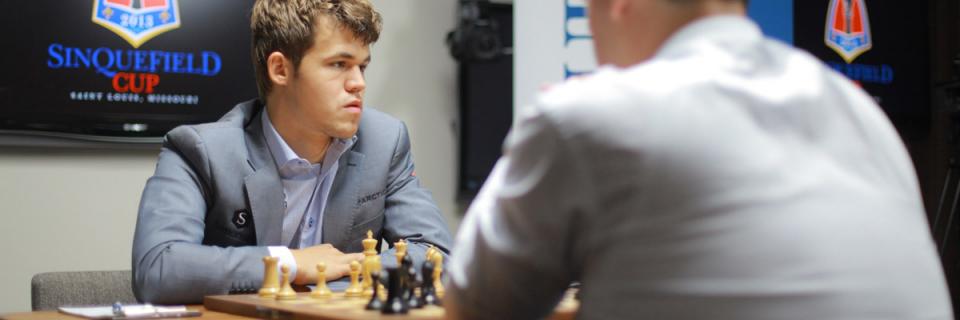
GM Magnus Carlsen had to play with extreme accuracy to knock off the reigning U.S. Champion, GM Gata Kamsky, in round 1 of the Sinquefield Cup.
Pairings for Round 2
| No. | White | Rating | Result | Black | Rating |
|---|---|---|---|---|---|
| 1 | Aronian, Levon | 2813 | - | Carlsen, Magnus | 2862 |
| 2 | Nakamura, Hikaru | 2772 | - | Kamsky, Gata | 2741 |
GM Hikaru Nakamura, GM Levon Aronian, Lindenwood University student George Krasnapolskiy GM Magnus Carlsen and GM Gata Kamsky pose during the autograph signing on September 8.
By Brian Jerauld
SAINT LOUIS – After a celebration weekend that began with the drawing of lots and finished with the drawing of crowds, the strongest chess tournament in American history is ready for its first move.
The Sinquefield Cup has arrived.
The top-2 players on earth – Norway’s Magnus Carlsen (FIDE No. 1, 2862) and Armenia’s Levon Aronian (FIDE No. 2, 2813) are set for battle with the top-2 players in the U.S., Hikaru Nakamura (FIDE No. 9, 2772) and Gata Kamsky (FIDE No. 16, 2741). Today at 1:00p.m., Carlsen will command white to attack Kamsky, while Nakamura takes the first move against Aronian.
The four superheros settled up on rules with International Arbiter Chris Bird during Saturday’s players meeting and drawing of lots. The Sinquefield Cup will follow a double round-robin format across six rounds, with players meeting each other twice – once as the white pieces and once as black. Time control will be 90 minutes for the first 40 moves, with an additional 30 minutes added after move 40 and 30-second increment for each move. No draw-by-agreement will be allowed before move 30. All rounds will begin at 1:00 p.m. local time, except for next Sunday’s final round, which will begin at 11:00 a.m, with a 6:00 p.m. playoff if necessary. Thursday will be a rest day.
A commemorative gift for the players, given during Saturday’s meeting, will simultaneously serve as a technological gift to the rest of the chess world. Bridging the connection between happy grandmasters and happy fans, the Sinquefield Cup will feature the first-ever DGT-enabled weighted sets. The electronic boards, which instantly cast games into digital form and fuel streaming commentary worldwide, have long drawn the ire of having sets that were too light – though any attempt to add metals as weight would disrupt the DGT sensors.
To tackle the perpetual problem, Rex Sinquefield, founder of the Chess Club and Scholastic Center of Saint Louis and sponsor of the Cup, put a phone call in to a literal rocket scientist: Frank Camaratta, a retired director of engineering for Pratt & Whitney aerospace manufacturer, and the founder of legendary chess set manufacturer House of Staunton.
“I have always wanted to make a nice-looking set that was fit for international play, and a nice weighted set for DGT boards was all part of the package,” Camaratta said. “After talking with Rex, I realized his vision was a lot like mine: This is a world-class tournament, and these professional chess players should be playing on the best equipment possible, to the level that these players deserve.”
Guided by Sinquefield’s style requests – ebony wood hand carved in the Imperial Collector design – Camaratta put some science into chess’ weight problem, figuring out the trick to DGT-allowable density and unlocking one of the hottest proprietary secrets in the game.
Also revealed at Saturday’s players meeting was the physical Sinquefield Cup, designed to be a recognizable championship trophy for years to come. The 24-inch representation of the King chess piece, a stylistic blend of Honduras Rosewood and brushed silver, will bear the names of winners throughout the years, residing on display in the tournament hall of the host Chess Club and Scholastic Center of Saint Louis. The winner, along with the $70,000 top prize, will receive a smaller 15-inch replica of the trophy.
"We wanted to create something timeless, classic and beautiful," said Chess Club Executive Director Tony Rich. "We hope this trophy will become the most sought-after chess hardware in the world."
With the rules, pieces and prizes out of the way, Sunday marked Signing Day in Saint Louis, where the players were available to the public for autographs and pictures. In true celebration of this first-in-a-lifetime event, more than 200 chess fans came from all corners of the nation to see Carlsen in his first tournament on American soil – and his last before November’s World Championship – or to shake hands with their favorite U.S. hopeful. By the signing session’s end, Aronian had developed his own cheering section, draped with several Armenian flags and applauding their national hero in the street.
From there, the four super stars were whisked away and brought in front of 60,000 new fans – welcomed during the halftime of the Saint Louis Rams game, where Carlsen took in his first-ever game of football.
That is: American football.

